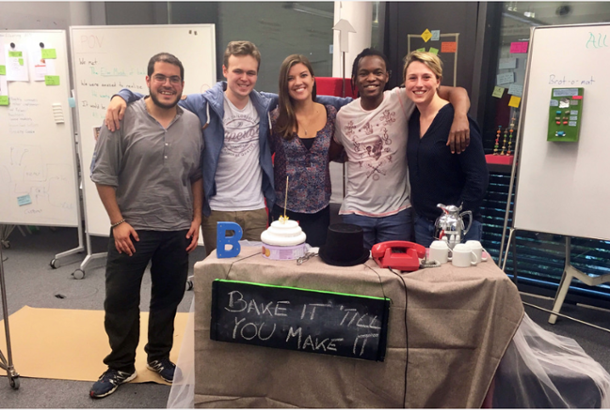
Penn State senior Elizabeth Miller, third from left, poses with her design team during Global Design Thinking Week at the Hasso-Plattner-Institut in Potsdam, Germany.
Schreyer Scholar takes international approach to design thinking
10/25/17
UNIVERSITY PARK, Pa. —Elizabeth Miller spent a week working on an engineering design project with teammates from Germany, Egypt and South Africa. The Schreyer Scholar and mechanical engineering major discovered that while people around the world in various professions continue to use technology to varying degrees, the ways problem-solvers help them use it are very often the same.
“Not only were we culturally diverse, but we were different genders, different ages, so it was cool to see what problems we ran into as a team from that standpoint, but also seeing that the problems are the same,” Miller said. “No matter who’s on the team, we’ll all human.”
As part of the Penn State Engineering Design program’s partnership with Global Engineering Teams (GET) and the School of Design Thinking at Hasso-Plattner-Institut (HPI), Miller traveled to Berlin in September with a contingent of Penn State graduate students and faculty, including Matthew Parkinson, professor of engineering design and mechanical engineering and director of the Bernard M. Gordon Learning Factory; Sarah Ritter, assistant professor of engineering design; Charlie Cox, assistant teaching professor of engineering design; and Meg Handley, associate director of engineering leadership outreach and assistant teaching professor of engineering leadership.
Part of Miller’s time in Germany was spent working on a GET project with Amparo, a global company that designs prosthetic devices. She also participated in Global Design Thinking Week, hosted by HPI. The five-day design workshops, which included participants from 20 countries, focused on bringing technology into craft businesses.
“The first day was all about unpacking the problem, understanding it,” said Miller, who is participating in the Engineering Leadership Development minor through the School of Engineering Design, Technology, and Professional Programs (SEDTAPP). “We spoke to a man from the bakers’ association in Berlin about what his needs were, then we went out and did field work in bakeries around Berlin and spoke to the bakers themselves to see what their needs were, what they thought could be improved.”
Miller’s team was tasked with developing an application that would help bakers stay up-to-date on industry trends.
“For example, chia seeds are really taking off,” Miller said. “This would create a database that would pull from the internet and let bakers know people are really into chia, so they would maybe create a new product and attract younger people to come to their bakery.”
The group visited three different bakeries. The first was the oldest bakery in Germany, which eschewed technology and whose owners had no interest in adding technology. The second bakery, which had three locations, placed a high priority on embracing trends and innovation, while the third, which had 30 different locations, was already using technology to a large extent.
“You saw very different perspectives,” Miller said. “Some people wanted to embrace technology and change, and some were, ‘If it’s not broke, don’t fix it.’”
Miller’s group used an application to develop a prototype of its database app. Other groups in the program worked with construction workers, opticians, dentists, butchers, electricians or woodworkers to develop similar applications. Each group was responsible for developing a pitch and creating a booth to show off the results.
It wasn’t the first time Miller had done design work abroad — she traveled to Singapore for an engineering design class project during her first year at Penn State — but it reaffirmed her desire to create or design products.
“I also realize that the skills I picked up from this are going to be applicable in literally anything,” she said, “because I think design thinking is just this way of thought that is centered around empathy and collaboration with others and being open to new ideas, and I think you can apply that in any area of life.”
Miller did her coursework in the evenings and toured as much of Berlin as she could. She will spend the next few months working on the GET project with her intercultural team, with a possible culmination trip in the spring. Her experience in Germany was a reminder that others’ perspectives might be the best tool in any design strategy, even or especially if there’s a language barrier.
“The biggest thing I learned was not to project your own experiences onto a user,” she said. “You never have the full picture. You have to listen to them and just not put in bias.”
The School of Design Thinking at HPI is directed by Dr. Claudia Nicolai.


